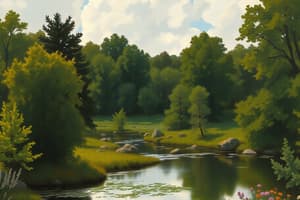Podcast
Questions and Answers
What percentage of land in the provided categories is identified as forest?
What percentage of land in the provided categories is identified as forest?
- 12.0%
- 40.36% (correct)
- 4.38%
- 21.0%
Which physiographic zone of Nepal has the highest number of ecosystems?
Which physiographic zone of Nepal has the highest number of ecosystems?
- High Mountains
- Siwalik
- Middle Mountains (correct)
- Terai
Which of the following categories has the least area according to the data?
Which of the following categories has the least area according to the data?
- Grass land
- Urban and industrial areas
- Water, streams, and river beds (correct)
- Other Wooded Land
What is the combined percentage of land classified as Agriculture land and Grass land?
What is the combined percentage of land classified as Agriculture land and Grass land?
What has prompted farmers to start planting trees on their farmland?
What has prompted farmers to start planting trees on their farmland?
How many ecosystems are classified in the High Mountains physiographic zone?
How many ecosystems are classified in the High Mountains physiographic zone?
Which of the following categories covers the area of 3.09 million hectares?
Which of the following categories covers the area of 3.09 million hectares?
What historic tradition is associated with agroforestry as mentioned?
What historic tradition is associated with agroforestry as mentioned?
What is one of the advantages of adopting agroforestry systems?
What is one of the advantages of adopting agroforestry systems?
Which of the following is a challenge faced in agroforestry development?
Which of the following is a challenge faced in agroforestry development?
What is a significant ecological benefit of agroforestry?
What is a significant ecological benefit of agroforestry?
Why might farmers in the terai region prefer tree planting over agroforestry practices?
Why might farmers in the terai region prefer tree planting over agroforestry practices?
What is a common misconception about agroforestry?
What is a common misconception about agroforestry?
Which problem is associated with growing crops in agroforestry?
Which problem is associated with growing crops in agroforestry?
In agroforestry systems, what is a consequence of rapid regeneration of aggressive tree species?
In agroforestry systems, what is a consequence of rapid regeneration of aggressive tree species?
What type of knowledge is often lacking among farmers when it comes to implementing agroforestry?
What type of knowledge is often lacking among farmers when it comes to implementing agroforestry?
What is one primary benefit of combining agricultural crops with trees in agroforestry?
What is one primary benefit of combining agricultural crops with trees in agroforestry?
Which of the following tree products can provide direct cash benefits in agroforestry?
Which of the following tree products can provide direct cash benefits in agroforestry?
What role do leguminous tree species play in agroforestry?
What role do leguminous tree species play in agroforestry?
How does agroforestry help in utilizing wasteland?
How does agroforestry help in utilizing wasteland?
Which of the following is NOT considered a diversified product from agroforestry?
Which of the following is NOT considered a diversified product from agroforestry?
What raw material is provided by trees for industries in agroforestry?
What raw material is provided by trees for industries in agroforestry?
Which employment opportunity is a result of agroforestry systems?
Which employment opportunity is a result of agroforestry systems?
What is an important benefit of trees providing shelter in agroforestry?
What is an important benefit of trees providing shelter in agroforestry?
What is the primary objective of social forestry?
What is the primary objective of social forestry?
Which statement accurately describes agroforestry?
Which statement accurately describes agroforestry?
What is a key characteristic of social forestry?
What is a key characteristic of social forestry?
How does agroforestry contribute to the local population?
How does agroforestry contribute to the local population?
What benefit does social forestry provide to marginalized rural communities?
What benefit does social forestry provide to marginalized rural communities?
Which of the following best describes the management practices in agroforestry?
Which of the following best describes the management practices in agroforestry?
What is the purpose of integrating multiple components in agroforestry?
What is the purpose of integrating multiple components in agroforestry?
Which of the following is NOT a goal of social forestry?
Which of the following is NOT a goal of social forestry?
What defines a complementary interaction in tree-crop systems?
What defines a complementary interaction in tree-crop systems?
What does the equation I = F - C represent in tree-crop interaction?
What does the equation I = F - C represent in tree-crop interaction?
Which interaction occurs when the yield of one component exceeds that of its sole crop without impacting the other?
Which interaction occurs when the yield of one component exceeds that of its sole crop without impacting the other?
What is the primary characteristic of alley cropping?
What is the primary characteristic of alley cropping?
What is the main benefit of improved fallow compared to bush fallow?
What is the main benefit of improved fallow compared to bush fallow?
What is the primary purpose of windbreaks in agroforestry systems?
What is the primary purpose of windbreaks in agroforestry systems?
In the context of tree-crop interactions, which of the following is a direct benefit of effective nutrient cycling?
In the context of tree-crop interactions, which of the following is a direct benefit of effective nutrient cycling?
What does riparian boundary planting primarily focus on?
What does riparian boundary planting primarily focus on?
Flashcards are hidden until you start studying
Study Notes
Land Use Categories in Nepal
- Total land area: 15.49 million hectares, exceeding 100% due to overlapping categories.
- Forests cover 5.96 million hectares, comprising 40.36% of total land.
- Other wooded lands amount to 0.64 million hectares (4.38%).
- Grassland totals 1.77 million hectares (12%).
- Agricultural land encompasses 3.09 million hectares (21%).
- Non-cultivated land accounts for 1.03 million hectares (7%).
- Water bodies cover 0.38 million hectares (2.6%).
- Urban and industrial areas occupy 2.62 million hectares (17.8%).
Ecosystem Diversity in Nepal
- Nepal hosts 118 distinct ecosystems.
- Middle Mountains hold 53 ecosystems (44%).
- Other significant zones include High Mountains (38 ecosystems, 32.2%) and Terai (12 ecosystems, 10.2%).
- Siwalik region features 14 ecosystems (11.9%).
Concept of Agroforestry
- Agroforestry integrates food crops, trees, and animals, nurturing a sustainable environment.
- Historical practice with roots in ancient agriculture by notable figures like Maharishi Kashyap, emphasizing tree planting on various land types.
- Contemporary necessity arises from dwindling forest resources, leading to increased prices for wood-related products.
- Farmers increasingly adopt agroforestry to supplement traditional agriculture.
Social Forestry vs. Agroforestry
- Social forestry focuses on community benefits, including fuel wood and timber supplies for local populations.
- Agroforestry is a sustainable method maximizing productivity through integral use of crops and trees.
- Social forestry enhances forest areas, whereas agroforestry promotes self-sufficiency through diverse land management.
- Key practices include planting trees on community lands, improving rural livelihoods.
Scope and Benefits of Agroforestry
- Offers solutions for ecological issues, fuel shortages, unemployment, and meeting population demands.
- Suitable for various marginal lands, enhancing land use efficiency through multi-use systems.
- Encourages employment opportunities and provides materials for local industries.
- Enhances soil and water conservation, improves ecosystem balance, and addresses fodder and fuel shortages.
Challenges in Agroforestry
- Complexity arises from diverse farming needs, complicating machinery use and risking crop damage.
- Labor intensity increases and migrant labor losses challenge system implementation in Terai and mid-hills.
- Limited technical knowledge and resources restrain effective agroforestry management.
- There’s an urgent need for improved education and capacity building in agroforestry among farmers.
Tree-Crop Interactions in Agroforestry
- Defined interactions between trees and crops affect resource utilization and agricultural productivity.
- Quantification of interactions reflects positive soil impact versus competition for growth resources.
- Complementary interactions stimulate mutual growth benefits, while supplementary interactions enhance production without harming either component.
- Efficient nutrient cycling and microclimate improvement are key outcomes of these interactions.
Studying That Suits You
Use AI to generate personalized quizzes and flashcards to suit your learning preferences.




